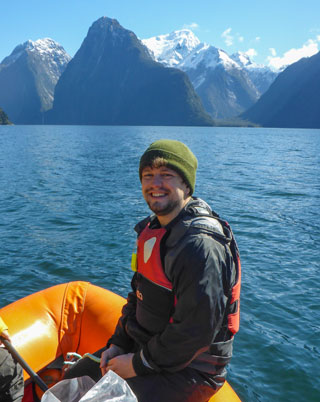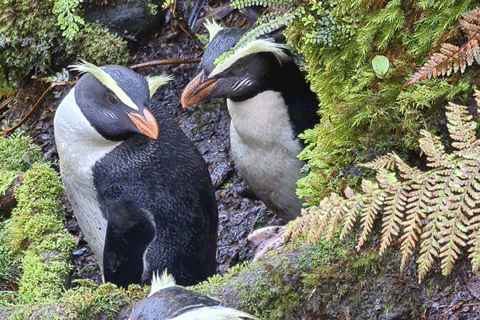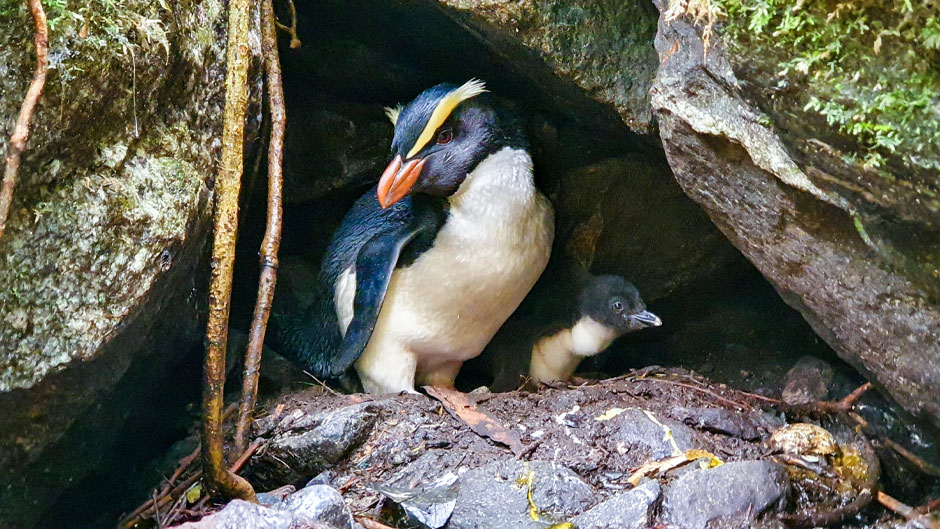To some, sleeping in a small tent in the rain with penguins screeching in the distance may not seem relaxing.
But for University of Miami biology graduate student Jeffrey White, the environment helps lull him to sleep.
“It’s comforting,” White said, recalling a time he was awoken by two penguins trying to burrow under his tent to make a nest.
He is grateful for these up-close experiences. White spent much of last semester in southwestern New Zealand studying the Fiordland penguins, also known as the Tawaki, a rare species that is thriving at a time when other penguin populations are struggling to survive amid global climate change. The Tawaki mate and raise their young in the fjords of New Zealand, and their unique features intrigued White immediately.
“They live in the rainforest and breed in the most lush environment you’ve ever seen—among tree ferns and moss,” he said. “The Tawaki also don’t live in tightly packed colonies like other penguins do. Instead, they live in sparsely placed caves in the same general region. And while they are on the water, they travel the longest distance of any penguin species.”

The species are also the only crested penguins—they have a yellow stripe of feathers on their head—to breed in mainland New Zealand. And they are one of the few species that live within range of humans while they raise their young chicks. Despite this, there is also little research on them, which makes the Tawaki ideal to study, according to White. Each colony typically has about 40 to 200 penguins living near each other. White spent time studying five colonies last semester but hopes to venture to others in the future.
For his dissertation, White is trying to understand what the Tawaki eat during different times of the year, which toggles between months at sea and periods of time on land to breed, molt, and grow new feathers. He is also studying their genetic variations and diving physiology. In addition, White is trying to understand how deep and far the Tawaki can swim on one breath, as well as where the penguins go on their long voyages. All of this will help researchers understand if the species is being impacted by climate change, pollution, or fisheries, and also pinpoint what helps the penguins to thrive.
“During the time they leave the waters around New Zealand, they travel some 4,600 miles and return as the fattest penguins that exist. So, clearly, they are doing something right, but we don’t know yet why they go so far away,” White explained.
To determine where they are going and what they are eating, White must take blood and feather samples from the penguins, which is tricky business. But the techniques he has learned from working with the Tawaki Project allowed him to collect and analyze samples, as well as to identify stable isotopes from the seabirds. These isotopes can help determine their diet at different times of the year, as well as where they might have eaten certain fish or squid. He learned some of these methods during his master’s degree program, but White is now getting more guidance from Hilary Close, assistant professor of ocean sciences, and his dissertation advisor, Kevin McCracken, associate professor of biology and an expert on the genetic evolution of waterbird populations. McCracken is helping White to explore the genetics of the Tawaki and their offspring.
“If you have two penguin populations living within or among different fjords, you can take samples to determine if they are genetically distinct,” said McCracken, the Kushlan chair of Waterbird Biology and Conservation. “And it would be helpful to learn about the genetic variation between different colonies. Because the more genetic variation that the Tawaki have, the more adaptable they are, which is good for their survival.”
All this information could ultimately help scientists, conservationists, and park managers to understand the Tawaki species and to protect the seabirds and their habitats.
To those that know him well, it’s no surprise that White is studying birds. As a child, he raised ducks; and years later, his family’s northern Mississippi farm turned into an aviary with up to 200 animals—which included pigeons, chickens, peacocks, and pheasants. In college, White got interested in wetland birds and spent the summer after graduation in the Patagonia region of Argentina volunteering for a group that studies the Hooded Grebe, a bird native to southern Argentina. And it was during his time there that White got a chance to travel farther south and see penguins in the wild for the first time. He took a guided tour to Isla Martillo, where he visited a colony of Gentoo and Magellanic penguins.
“They were telling us about the threats that penguins face and how little we know about them,” White said. “That experience ignited something in me; and afterward, I knew I wanted to study penguins. There’s so much we need to learn, and now is the time to do it before it’s too late.”

Penguins are widely considered a sentinel species for the health of marine ecosystems overall. So, if the health of penguins is declining, it may signal that aquatic ecosystems are stressed. This could later become a problem for humans, who rely on the oceans for food and income.
White researched penguin species and landed on the Tawaki because they were doing relatively well, compared to other penguin populations whose habitats are melting. During his master’s degree program, White reached out to the Tawaki Project, founded by the scientist couple Thomas Mattern and Ursula Ellenberg, and began doing hands-on research with them in 2016. He is now part of the team and has visited New Zealand four times. Through the project, White has spent time in five different Tawaki colonies—watching penguin parents raise their chicks—and is exhilarated to learn more.
“My goal is to provide information about how the Tawaki will respond to different climate change scenarios, so we can know more about what they are doing now and what they need to access. Then, we can compare that to models for the future, to see what works,” he said. “Hopefully, this fall we will go to some islands in the New Zealand subantarctic to study two new species of penguins that are closely related to the Tawaki.”

